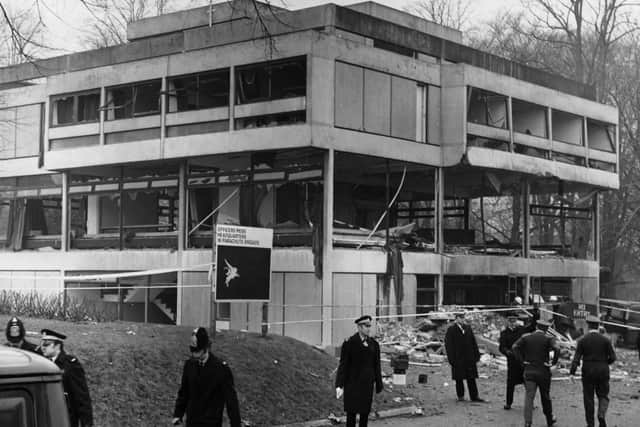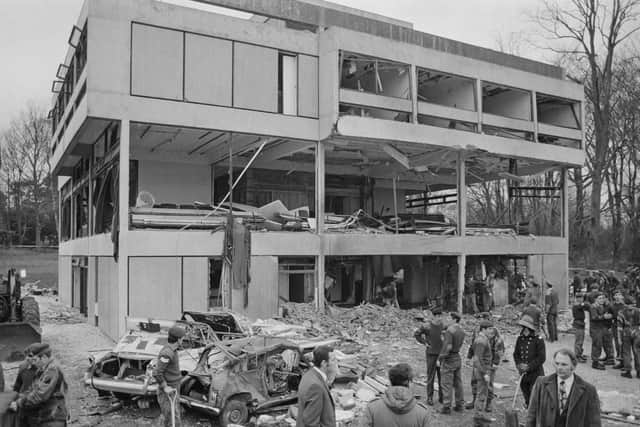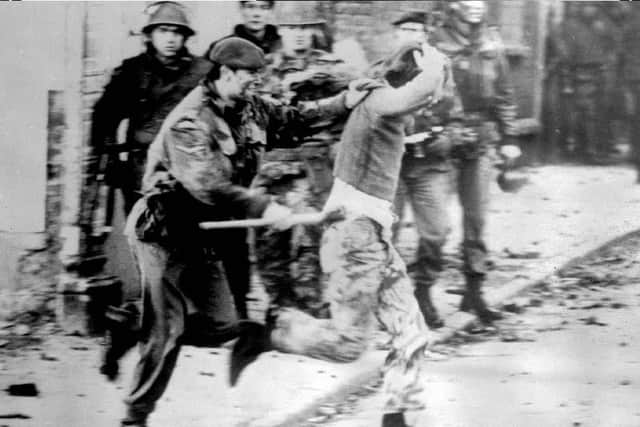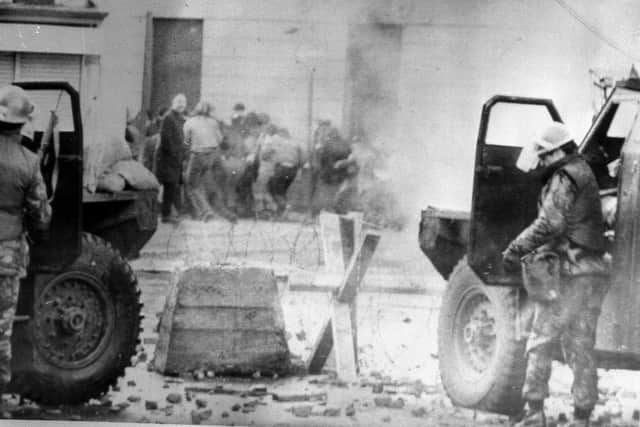Poulton great-granddad who survived IRA bomb that killed seven to walk on wings of soaring plane in aid of injured veterans


Great-granddad Cedric Sharp, of Longhouse Lane, Poulton, was caught in a car bomb attack outside the headquarters of the 16th Parachute Brigade in Aldershot, Hampshire, in 1972.
He had been walking down the street opposite the open garrison when a Ford Cortina packed with 280lbs of explosives went off in the headquarters’ car park, destroying the mess hall and killing four kitchen staff, a gardener, and a Catholic priest.
He was shielded from the blast by a large mound of earth.


Advertisement
Hide AdAdvertisement
Hide AdHe said: “I was going home to the quarter that my wife and children were in when the bomb went off right outside the parachute officers’ mess.
“The explosion knocked me off my feet and I got an injury to my foot which was alright at the time, but the medic said it would take it’s toll in later life, which sure enough it has done.“My first reaction was to shout at everyone to get back.
“In those days, they were sometimes setting one bomb off and then planting another one to go off five minutes later when the place was filled with do-gooders trying to help people, so I had to tell everyone to get back.
“Very quickly on the scene were the Parachute Regiment themselves.


Advertisement
Hide AdAdvertisement
Hide Ad“The explosion was felt all the way through to Aldershot town centre. It was a heck of an explosion.
“It was a devastating sight, and even now I find it difficult to adequately describe.”
Despite his injury, Cedric went on to make a good recovery and continued his army career until 1989, when he departed to set up his own financial services business.
Now, at 81, he will take to the skies on the wing of a plane soaring at 135mph over the green fields of Yorkshire to raise money for SSAFA, the Armed Forces charity, which provides lifelong support to serving men and women and veterans injured in the line of duty.


Advertisement
Hide AdAdvertisement
Hide AdHe said: “Anybody who is injured at all, SSAFA immediately goes out. They re on 24 hours a day and they support the families as well as the soldiers - and it’s not just the army, It’s the Royal Navy and Air Force as well.
“It doesn’t matter who or how the serviceman has been injured.
“We have to raise money for SSAFA. They get a certain amount of money from the Government, but it’s paltry.
“I’ve already raised over £1,000, but I’m hoping for £8,000. It’s an interesting thing to do, and it catches the eye, like when a boxer gives that knock-out punch.


Advertisement
Hide AdAdvertisement
Hide Ad“I could go running and swimming - I’m still fit as a butcher’s dog - but this I thought would be something that really grabbed the mind. An 81-year-old man, going on 82, wing walking - you don’t see that every day.
“I’m looking forward to it. I can’t wait to get there.”
Cedric, who was born in York, joined the army at 21 and worked in various roles for the service, mainly as a physical training instructor, during his 30-year career.
From 1975 to 1977, he served in Hong Kong as part of the 48th Gurkha Infantry Brigade.
Now he is putting his skills to good use with a home training regime, including sit-ups and press-ups, to ensure he stays in good shape ahead of his daring wing walk.
Advertisement
Hide AdAdvertisement
Hide AdHe said: “The army was the best time of my life. There was always plenty to do, always plenty going on, always places to go. I’m training now to keep my weight down because if you’re more than 77 kilos, and if you turn up and you’re overweight, they will not fly you. I make the weight already because I’ve been working on it.
“It’s very, very simple to keep fit.
“The one thing you have got to be able to prove is when the aircraft is on the ground and you’re preparing to fly, you need to be able to climb up without any assistance. If you’re not fit enough to climb up onto the wing yourself they will send you home. I’m not worried about that.
“My son, my daughter and my wife all know what I’m like. They say ‘oh, you’re at it again!’ They’re all going to come and cheer me on.”
Jim Morrison, head of community fundraising at SSAFA, said: “Cedric’s wing walk is an incredibly brave and exciting way to raise money for SSAFA and we are extremely grateful. The money raised will go a very long way in helping us support the military community”.
Advertisement
Hide AdAdvertisement
Hide AdCedric will fly from Selby, Yorkshire, on a bi-plane on May 12. He hopes to raise at least £8,000 for SSAFA in sponsorship.People can donate to Cedric’s fundraiser online at www.justgiving.com/fundraising/cedric-sharp-wing-walking.
The 1972 Aldershot bombing
The 1972 Aldershot bombing was a car bomb attack carried out by the Irish Republican Army as revenge for Bloody Sunday, when British soldiers shot 28 unarmed civilians during a protest march, killing 14 of them.Seven civilian staff, mostly female cleaners, were killed and 19 were wounded in the bombing. It was the Official IRA’s biggest attack in Britain during The Troubles. The target of the attack was the 16th Parachute Brigade headquarters. A Ford Cortina car containing a 280lb timed bomb was left in the car park of the garrison outside the officer’s mess hall. It exploded at 12:40pm on February 22, destroying the officer’s mess and damaging several nearby army office buildings.The British soldiers who were the intended targets were not present in the mess hall at the time, as the regiment was stationed elsewhere. Five female members of kitchen staff, Mary Bosley, Jill Mansfield, Joan Lunn, Sheri Munton and Margaret Grant, were killed in the explosion, along with a gardener, John Hasler, and a Catholic priest and captain called Gerard Weston.The Official IRA claimed responsibility for the attack, but said: “Any civilian casualties would be very much regretted as our target was the officers responsible for the Derry outrages.”The group was harshly condemned for the bombing.Noel Jenkinson was jailed for life for the bombing in November 1972 and died in prison of a heart attack four years later.
Bloody Sunday
The Aldershot bombing was a revenge attack carried out one month after Bloody Sunday.On January 30, 1972, in Derry, Northern Ireland, civil rights campaigners marched through the neighbourhood of Bogside.Though the chief superindendent of the Northern Ireland Police Force suggested no action should be taken against them, British army soldiers, including those from the Parachute Regiment, were deployed to ‘contain’ the march, with the instructions to use rubber bullets, water cannons and tear gas if protesters tried to leave the prescribed areas.Clashes broke out between some protesters and the army. The first gunshots were fired at 3.55pm, and shortly afterwards paratroopers began seizing people. There were reports of paratroopers beating people, clubbing them with rifle butts, and firing rubber bullets at them from close range.One group of paratroopers took up position at a low wall front of a rubble barricade on Rossville Street, where the protest was taking place, and open fired on the crowd, killing six people and wounding a seventh.A large group of protesters fled into the courtyard of nearby flats, called Rossville Flats, where soldiers opened fire on them, killing 17-year-old Jackie Duddy and wounding six other people.Another group of people fled into another courtyard area, Glenfada Park, where they were shot at by soldiers. Two people were killed, and four were wounded.A further four unarmed civilians were shot dead by soldiers elsewhere.In total, 28 people were shot by the paratroopers. 13 of them died on the day and another died of his injuries four months later.The victims were John Duddy, 17, Michael Kelly, 17, Hugh Gilmour, 17, William Nash, 19, John Young, 17, Michael McDaid, 20, Kevin McElhinney, 17, James Wray, 22, William McKinney, 27, Gerard McKinney, 35, Gerard Donaghy, 17, Patrick Doherty, 31, Bernard McGuigan, 41, and John Johnston, 59.Only one of the victims was found to have been carrying a weapon, and many were attempting to flee when they were shot. An inquiry decades later found none of them had posed a threat of causing death or serious injury.
The Troubles
The Troubles, also known as the Northern Ireland Conflict, refers to the three-decade long conflict between the nationalists and unionists.Nationalists mainly identified themselves as Irish and Roman Catholic, while unionists mainly identified themselves as British and Protestant.The Troubles began in Northern Ireland in the 1960s, which escalated after 1969 to include armed campaigns by the IRA, Ulset loyalist Protestant groups, and the British Army.The British Government asserted that the army was involved to uphold law and order in Northern Ireland, but they were seen as an invading force by nationalists.More than 3,500 people were killed during The Troubles. Some 2,058 deaths were attributed to Republican paramilitary groups, 1,027 were attributed to Loyalist paramilitary groups, and 363 were attributed to British security forces. Five people are believed to have been killed by Irish security forces, and 79 are believed to have been killed by persons unknown.Around 52 per cent of all those who lost their lives were civilians.The Troubles reached an uneasy conclusion in the late 1990s following declarations of a ceasefire by the IRA in 1997, and later by the Irish National Liberation Army in 1998.